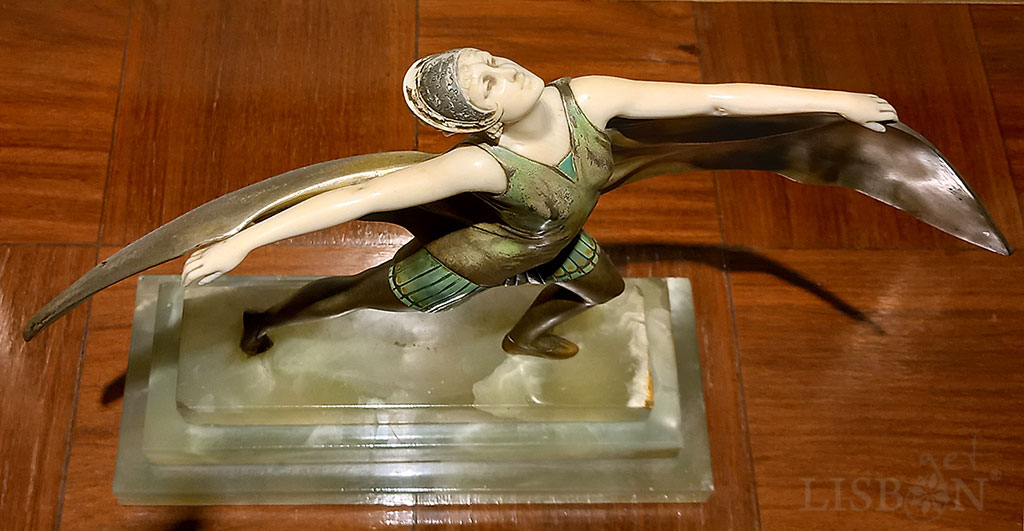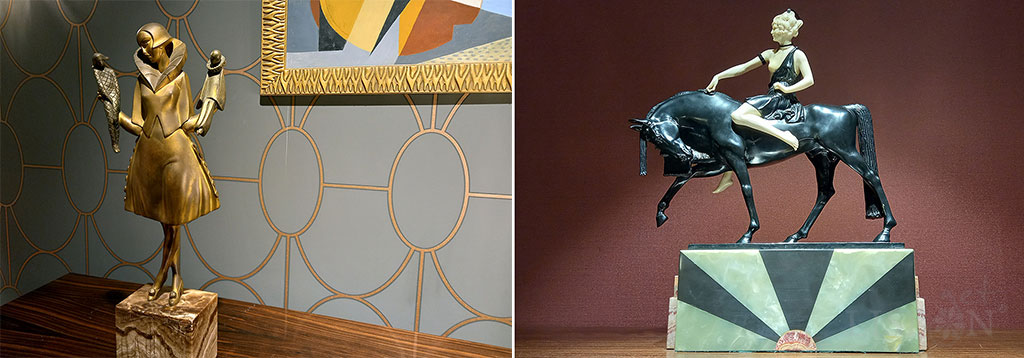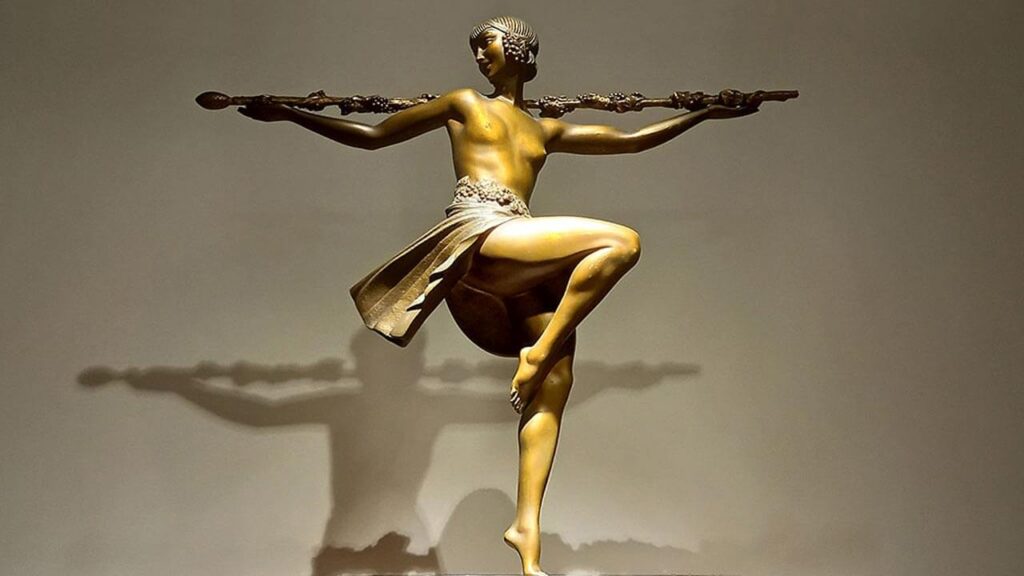Today we invite you to visit B-MAD, Berardo – Museum Art Deco, an immersion in a world of beauty, know-how and creativity that transports us to the dominant aesthetic currents during the transition of the 19th to the 20th century.
The Museum

The Berardo – Museum Art Deco is located in a building of the 18th century, built after the earthquake of 1755 as a summer house of Marquis of Abrantes.
This building situated in Alcântara, on Rua 1º de Maio, was later on the residence of António Flores (1883-1957), neurologist, psychiatrist and professor, first director of Júlio de Matos Hospital.
At that time, the prestigious doctor promoted an architectural transformation, signed by the architect Raul Lino (1879-1974), who added a floor, an observation tower and a staircase. Moreover, in the place of the old chapel ruin, he built a building for rent for the Flores family, which is also occupied by the Museum nowadays.
The beautiful property also had a small botanical garden in the backyard that was destroyed in order to install one of the pillars of the bridge over the Tagus river. Stuck under the grand but noisy bridge, it lost attraction and value. It was thus abandoned for many decades, with only the ground floor remaining occupied by a few shops.
In 2016, collector José Berardo acquired the property with the intention of moving here his collection of decorative art pieces produced in the last decades of the 19th century and first decades of the 20th century.
The renovation of the building sought to preserve the interior typology, in which the staircases and the rich stucco work on the ceiling of some rooms stand out. The walls were painted with colours and lined with wallpaper, in accordance with the highlighted periods, reinforcing the experience of immersion in the Belle Époque and the Roaring Twenties.
The Berardo – Museum Art Deco Collection

The collection exhibited at B-MAD consists of pieces of furniture, lighting, sculpture, painting, drawings…, signed by some of the most outstanding artists of this period.
Of these, small statues are worth highlighting, which reproduce daring ballerinas and, as a curiosity, the representations of three personalities that reached great prominence at the time.
They are Isadora Duncan (1877-1927), North American choreographer and dancer, precursor of modern dance; Josephine Baker (1906-1975), famous black singer and dancer, also North American naturalised French; and the iconic actress Marlene Dietrich (1901-1992) born German and naturalised American.



Three Aesthetics of Know-How
Get ready to see representative examples of three aesthetic movements that marked Europe and spread throughout the world during the transition of the 19th to the 20th century and that share the same objective, the taste and practice of know-how: Arts and Crafts, Art Nouveau and Art Deco.

Arts and Crafts
It is an English movement, from the second half of the 19th century, which emerged as a reaction to the fierce industrialisation in progress. Its mentors were John Ruskin (1819-1900) and William Morris (1834-1896), who defended craftsmanship and know-how that, even then, were expected to be threatened by the growing mechanisation and massification.
Its aesthetics, which had nature and the appreciation of Japanese-inspired graphics as a major theme of inspiration, would be the starting point for the emergence of the Art Nouveau movement and the development of design in the 20th century.
Art Nouveau

This international aesthetic current, celebrated by various names depending on the place of development (Jugendstil, Style Moderne, Lo Stile Liberty or Stile Floreale, Nieuwe Kunst…), was an explosion of creativity that marked Europe in the last decade of the 1900s and the early years of the following century.
It was the sign of modernity present in the decoration of new shops and department stores, cafés, restaurants and new constructions in major European capitals and other smaller growing cities.
A style with local peculiarities but which, in general, had five main characteristics in common: the preference for organic counter-curved forms; the inspiration in plant and flower-inspired motifs; the female figure and universe; the combination of different materials in a piece; and the presence of author signatures.
Art Deco

This was followed by the Art Deco movement, which began shortly before the first major world conflict, but which will have its full development in subsequent years, unequivocally marking the 1920s and 1930s.
These were years focused on the fascination for speed, for unbridled consumption, for the eagerness to know and live all kinds of radical experiences.
The taste for luxury, for rich and exotic materials, for the exuberance contained in geometry, reaches its peak with this movement that marks the period between the two destructive wars.
Its aesthetic, as it appears in opposition to the previous one, transforms curved lines into straight lines; flowers give way to geometric patterns; the feminine coquette woman with long unruly hair emancipates herself, adopting the style à la garçonne, wears trousers and smokes in public…
Represented Artists in the Berardo – Museum Art Deco
At Berardo – Museum Art Deco, art pieces by artists from various origins equally diverse and extraordinary can be seen, such as: Émile Gallé (1846- 1904), Louis Tiffany (1848-1933), René Lalique (1860-1945), Camille Fauré (1874–1956), Pablo Picasso (1881-1973), March Zach (1891-1945), among many others.
When it comes to Art Deco furniture Eillen Gray (1878-1976), Jacques-Émile Ruhlmann (1879- 1933), Jean-Michel Frank (1895-1941), Alfred Porteneuve (1896-1949), Jules Leleu (1883-1961), Jacques Adnet (1900-1984) must be highlighted…
But national plastic artists such as Rafael Bordalo Pinheiro (1846-1905) and Canto da Maia (1890-1981) are also represented, as well as drawings and objects in silver from the Old Jewellery Shop Reis e Filhos do Porto and drawings from the project of Casa de Serralves of the same city.




The visit to Berardo – Art Deco Museum ends with a wine tasting in the cozy garden of the house. There you can see two street lamps designed by Hector Guimard (1867-1942) that side a cast iron sculpture that is also of French origin.
An experience without museum labels, with a guided tour, which calls for the pure enjoyment of art.
It is recommended to schedule it in advance, for the sake of safety and comfort.
You can and should complement your visit by previously downloading the catalog published for the Art Déco – Berardo Collection, What a Wonderful World! exhibition, at the Casa das Mudas Arts Centre, available on the museum’s website.
| Never miss another article | Subscribe here |
The project getLISBON has been very rewarding and we want to continue revealing the singularities of fascinating Lisbon.
Help us keep this project alive!
By using these links to make your reservations you’ll be supporting us. With no extra costs!
• Looking for a different experience? We can create a customised itinerary based on your interests. Contact us!
• Or if you prefer tours and other activities in various destinations, take a look at GetYourGuide.
• Save time and money with a flexible Lisbon Card!




